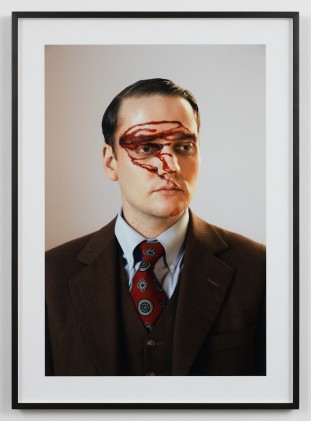IN HER CURRENT WORK, KERRY TRIBE APPROPRIATES CONTENT from Hollywood films, specifically those shot at the Greystone mansion in Beverly Hills, piecing together dialogue culled from over 60 films. “There Will Be” features the 30-minute original film Greystone, as well as a shorter video Bibliography, photographs of the bloodied actors, and works on paper that read like concrete poetry featuring lines taken from the scripts used to compile Greystone.
Greystone Mansion was the most expensive residence in California when it was built in 1929 and is imbued with its own intriguing history. It was the site of the murder that same year of its owner, Edward Doheny Jr. and his personal secretary Hugh Plunkett. The circumstances of the deaths were never solved and at the time it was widely speculated as to whether it was a double murder or murder/suicide.
Aware of the aura of mystery surrounding the Greystone mansion, Tribe researched its history. She has meticulously crafted a script that weaves together both well known and little known films that were shot on location in its various rooms. The mansion functions as the set, and is the only constant in the project, portrayed as a silent holder of an unattainable truth.
While strategies of appropriation have been in use by artists working in both film and photography for many years)—like Christian Marclay’s culling of clips relating to time in The Clock (2011) and the proliferation of art made from YouTube videos in the manner of Natalie Bookchin’s “Now he’s out in public and everyone can see” (2012)—Tribe montages fragments of Hollywood cinema to explore an unsolved mystery. In Tribe’s live action film five different scenarios of the murder are depicted. Each scene was shot in the actual rooms where the murders occurred. The actors are dressed in period costume from the time of the original Greystone murder and perform stereotypical roles: the jilted lover, the maid, the inspector, the closeted homosexual. They recite lines of conversation that simultaneously propel the narrative forward, yet sometimes appear to be out of context. Tribe adapted the dialogue to create multiple points of view and to offer different possibilities as to who might have committed the murder and why.
Those with an encyclopedic knowledge of film may recognize both the settings and snippets of dialogue Tribe uses and be able to connect them back to the actual scenes. Without this knowledge, however, the work still resonates. In much the same way as she appropriates images and language, Tribe engages with Hollywood’s practice of endless recycling. The mansion eventually became a popular location appearing as the backdrop for movies including Eraserhead, There Will be Blood, The Social Network and The Big Lebowski. In Tribe’s meta-narrative “There Will Be” she both critiques and embraces the myths of Hollywood and the ability of a dynamic medium like film to be a purveyor of truth.


